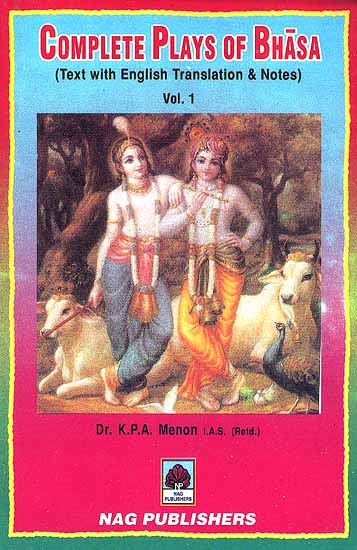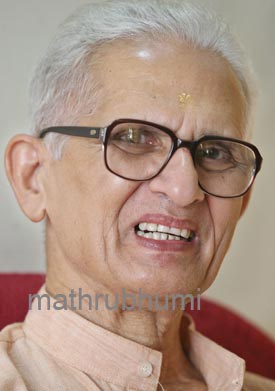December 30, 2011
The brooding grey skies that had been in labor since morning finally delivered by 6pm. Ominously cloudy day here as cyclone Thane's danse macabre powered through coastal Tamil Nadu towards Andhra. I am typing this as the weak drizzle attempts to drown urban noises.
Yesterday at the book fair, I picked up Bhasa's play, Karnabharam. Malayalam translation by Prof. Vishnu Narayanan Namboothiri. The slim book conveniently has the Sanskrit and Malayalam versions on facing pages. The 10-page play in a single act comes with an outstanding introduction by the translator.
Prof. Namboothiri has titled the introduction 'Malayalathinte Thala'. It can mean simultaneously Malayalam's head, Malayalam's brain, Malayalam's origin or Malayalam's epitome. The title is perhaps a conscious effort to imitate that glorious variety of the meanings of the play's title.
Karnabharam, directly, refers to the heavy heart of Karna, the hero, as he prepares for the battle. It could also mean that the story will weigh on our ears (karnam) for it is a tragedy.
As Prof. Namboothiri notes, Karnabharam and Urubhangam are two outstanding tragedies from ancient India, both by Bhasa, that can match any of the classic Greek tragedies.
The bulk of the introduction is the argument that Bhasa, the most famous and prolific Sanskrit playwright of antiquity, hailed from Kerala (hence 'Malayalathinte thala').
Before briefly recapping the main points that are listed in support of the claim, we should consider that the estimates of Bhasa's life period vary from the 5th century BC to the 3rd century AD. It is clear that he existed much before and was treated with nearly religious reverence by the time of Kalidasa who explicitly acknowledges and borrows profusely from Bhasa's works.
The Sanskrit used by Bhasa is somewhere between the hardcore orthodox Vedic version and the more flowery, imaginative, popular, softer tool that flourished with Kalidasa.
More importantly, Bhasa shows no awareness of the Natyashastra of Bharatamuni. He breaks too many of Bharatamuni's rules of the theater which have been strictly followed in Sanskrit theater ever since they were established. The existence of tragedies and the depiction of violence on stage by Bhasa clearly predate their tabooing by Bharatamuni.
So, the attempt is to establish the geographical location of a historical personality who lived somewhere within an estimated 800 year period!
Tough job, indeed!
But Vishnu Narayanan Namboothiri goes about the task passionately and I am naturally rooting for Thiruvananthapuram in this debate!
Though his works have been quoted in several subsequent Sanskrit works spanning more than thousand years, they were not discovered till 1910. That year, T. Ganapati Sastry discovered them on cadjan leaves at the Manalikkara Madom in Thiruvananthapuram. Eight plays of Bhasa were discovered in that compilation. But finding the plays in southern Kerala is obviously no proof that the author was from these parts. A more logical argument is that most of these stories have been enacted respectfully in Koodiyattam form in Kerala for centuries.
Prof. Namboothiri dismisses the common argument that Bhasa was from Ujjain. He correctly points out that Ujjayini was ancient India's "Greenwich". It was the center of a civilization that ascribed paramount importance to astronomical calculations (yea, the one that got hijacked and degraded into the quack astrology of today). The giant observatory and Mahakala (Great Time) temple still exist in Ujjain. Namboodiri argues that this Mahakala transmuted to Mahakali, the daimon, so to speak, of Kali-dasa. The same diety i.e. Ujjaini's Kali has become the common south Indian goddess, Uchumali Amman. Though the central observatory was in Ujjain, Kanyakumari, the cape of the peninsula, was preferred for observations of sunrises and sunsets and of the southern skies. An observatory existed in Agasthyakoodam peak nearby. When gods themselves can travel from Ujjain to the south and works of Vyasa, Valmiki and Kalidasa can become popular in Kerala, it is not too difficult to concede that Bhasa could have been famous in the north just like Sankaracharya became later on.
Against the argument that Sanskrit was never a popular language in Kerala in ancient times, Vishnu Narayan Namboodiri lashes out at the so called Indian "scholars" who still digest nonsense like "Indo-European" languages and Aryan/Dravidian divides; outdated ideas that their own originators like Max Mueller abandoned long ago. Some argue that native village singers in central India still sing an 'Udyanakatha' attributed to Bhasa.
Doesn't that sound a lot like Kerala's favorite martial arts folk hero 'Othenan', the professor asks!
The stronger argument comes in the geographical descriptions given by Bhasa. The land of tall palms, numerous rivers flowing west including Pamba, backwaters and lagoons and the towering Agasthyakoodam mentioned in Kalidasa's Raghuvamsam (based on Ramayana) is borrowed from Bhasa. If that is not southern Kerala that Rama and Sita see on their way back from Lanka, where else is it?! There is also Bhasa's propensity to mention Parashurama, the mythological creator of Kerala, in his works.
The essay moves onto two powerful arguments. 'Urubhangam' glorifies Duryodhana, the despicable,arrogant, selfish, rape-instigating, belligerent villain of the Mahabharatha. It narrates the repentance and pathos in his final moments as he lies immobile with his thighs shattered by Bhima in battle.
A moving tragedy!
Vishnu Narayanan Namboodiri suggests that the impact of this drama when it was staged and remained popular through centuries of koodiyattam enactment was that its hero achieved not just the sympathy but also divine attribution from the population. Consequently, the only temple in India dedicated to Duryodhana is at Malanada in Thiruvananthapuram.
To cap off, Namboodiri presence a linguistic oddity from Bhasa's Prathigyogandharayana that was brought to his attention by Dr. Paulose, the Sanskrit scholar and erstwhile principal of Sanskrit college. In that play, the minister and court jester, in disguise, enter into a conversation about the king of the Vatsa kingdom. Not wanting to reveal their identities nor that they are discussing about the king, the conversation proceeds with the double meaning usage of the word 'Vatsan' to refer to the king. Bhasa uses the fact that Vatsan is also the name of a popular sweet dish. However, leaf-wrapped dish is called Vatsan only in southern Kerala.
I spent most of yesterday evening reading Karnabharam. Truly classic! I have been wanting to read it ever since I saw the video of Mohanlal enacting the role of Karna in a staging, in Sanskrit, directed by the venerable Kavalam Narayana Panikkar.
Since I am encountering a little too much Sanskrit these days, we picked up a small guide to Sanskrit by Dr. Paulose who was mentioned earlier. "A Christian guy wrote a guide on Sanskrit?!" has been the standard reaction of disbelief that I have encountered since yesterday.
This obsession of the Malayalee with caste and religion is also to be found in the works of Bhasa. That then is the clinching argument for me!! Any author who pays much attention to the caste and religion must have come the land that repelled Swami Vivekananda as 'a madhouse of casteism'!
My grand plan is to use Prof. Paulose's guide with Karnabharam as a workbook to gain some familiarity with Sanskrit. Like the Zen master said, "we'll see!"
Besides C.V. Raman Pillai's Marthanda Varma mentioned in yesterday's note and the two books discussed above, we bought one by EMS Namboodiripad and another collection of essays by Kuttipuzha Krishna Pillai.
Tomorrow, the final day of a rather eventful year, globally and personally! And in another lovely mathematical coincidence, it will be the 150th day of my India stay!



No comments:
Post a Comment